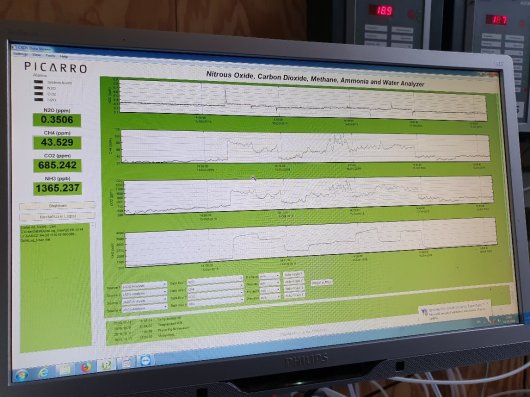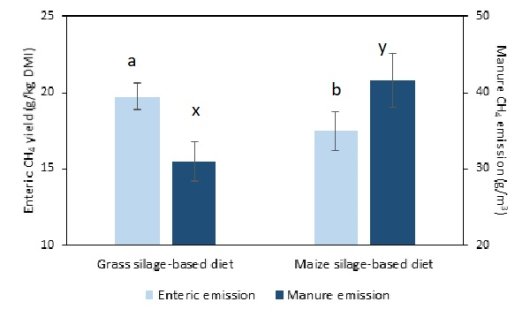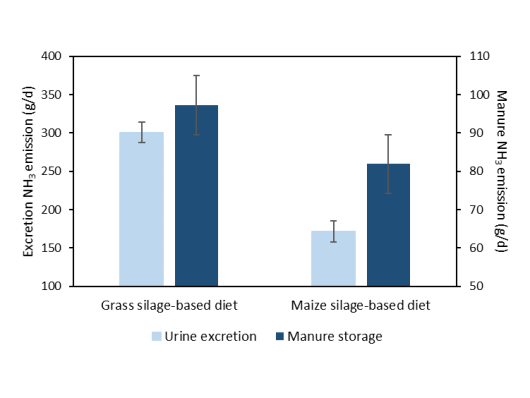
Nieuws
The effect of a dietary change in roughage composition on enteric and manure emissions from lactating dairy cows under practical housing conditions
The combination of emissions from enteric fermentation and from manure storage and cow housing was studied simultaneously under a practical setting at the research dairy farm Dairy Campus (Leeuwarden, the Netherlands). The enteric methane mitigating effect was studied while feeding a 50:50 concentrate to roughage ratio (on a dietary dry matter basis) and changing the roughage from 100% grass silage to 20% grass silage and 80% maize silage. We studied whether the expected lower enteric methane emissions on the maize silage-based diet was compensated by increased emissions from manure and housing as trade-off of the dietary mitigation measure. The study was performed in four units at Dairy Campus with a capacity of 16 dairy cows each, which can be closed off individually to measure gaseous emission on group level. (see above photo)
Project background
Capturing the integral effect of a dietary measure on on-farm GHG emissions requires that they are not only evaluated on their effect on enteric methane but also on accompanying changes in emission from stored manure and animal housing. Next to a potential trade-off of reduced enteric methane emission towards increased manure methane emissions, the effects on nitrogenous emissions also need to be accounted for. Depending on the type of mitigation measure, reduction of methane emissions may cause a trade-off or have a synergistic effect towards nitrogenous emissions. Studies reporting these gaseous emission sources simultaneously are sparse however. Therefore, several experimental designs and dietary treatments have been studied in CEDERS to fill this gap in knowledge; these include in vitro studies, respiration chamber trials and the current experiment under practical conditions on the research dairy farm Dairy Campus. Results discussed here involve the latter study, and allow a direct comparison with conditions on dairy farms in practice with a resembling feeding and housing management.
Measurements
Two dietary treatments were compared; a diet including 50% grass-silage and 50% concentrates and a diet including 10% grass silage, 40% maize-silage and 50% concentrates, both on dietary dry matter basis. The composition of the concentrate was identical for both diets. Hence, the maize silage-based diet had a lower protein content (i.e., 135 g/kg dry matter) than the grass silage-based diet (i.e., 172 g/kg dry matter). In total 64 lactating dairy cows were involved, blocked in groups of 4 based on days in milk, parity and milk yield. Cows within each block were subsequently assigned to 1 of the 4 stall units (i.e., 16 cows per unit). Each unit was equipped with a slatted floor and the cows had free access to drinking water and to the experimental diet. The trial consisted of 2 periods, in a cross-over design to eliminate the effect of stall unit. Each period consisted of 2 weeks adaptation to the experimental diets, 5 weeks of measurements with the cows housed in the stall units, and 1 week without the cows housed in the stall units (i.e., used to separate enteric emission from manure emissions). At the start of each period, conditions were standardized as much as possible by introducing identical volumes of a single batch of manure in the manure pit of each stall unit. In each of the 4 stall units, ventilation rates were measured and gas concentrations of carbon dioxide, methane, nitrous oxide, and ammonia in sampled air were measured with a Picarro analyser. Additionally, group feed intake, milk production and composition, and cow weight were recorded on a daily basis, as well as volume of manure produced. Manure was sampled at the start and at the end of each period to determine manure composition.

Preliminary results
The results clearly indicate lower (-11%) enteric methane emission (in g/kg dry matter intake) for the maize silage-based diet compared with the grass silage-based diet (Figure 1), which is according to expectations and literature. There was however a trade-off towards more (+34%) methane emission from manure (in g/m3 manure stored) for the maize silage-based diet (Figure 1) compared with the grass silage-based diet.
The emissions of ammonia were also clearly affected by the change in roughage composition. The emission of ammonia from manure storage (estimated from measurements during absence of cows in stall units) was not affected, only numerically lower for the maize silage-based diet (Figure 2). When considering the ammonia emission of the manure storage as baseline and correcting the ammonia emissions measured with cows present in the stall units for this baseline, we assumed to estimate ammonia emission from cow housing (i.e., representing excretion of urine, not manure storage). The results subsequently clearly indicated a lower (-43%) ammonia emission (in g/d) for the maize silage-based diet compared with the grass silage-based diet (Figure 2), likely due to the lower dietary protein content of the maize silage-based diet.


Key conclusions
The results indicate that under a practical setting, the exchange of grass silage for maize silage has a strong mitigating effect on enteric methane emission (-11% on average, with 50% roughage in dietary dry matter). This is according expectations as well as literature. However, the study also clearly identifies a trade-off between enteric and manure methane emissions. Under the current experimental conditions, the exchange of grass silage for maize silage resulted in a higher methane emission from manure (+34% on average). Furthermore, there was a strong reduction in ammonia emission with the maize silage-based diet because of the lower crude protein content of the diet.
This indicates that mitigation of enteric methane must be done cautiously and evaluated at the whole diet level, if a compensating effect through an increased manure emission is to be prevented. More manure organic matter (Volatile Solids) was produced whereas feed intake was fairly similar with the maize-silage diet, and may have been due to a lower organic matter digestibility for this combination of maize silage and 50% concentrates in dietary dry matter.
It is concluded that despite proof of enteric methane and ammonia mitigating effects, the risk of trade-offs has to be considered and careful nutritional balancing for optimizing rumen fermentation and digestibility is pivotal to benefit from an enteric methane mitigation feeding measure. This means that quick solutions and that adopting the concept of “one size fits all” is probably unrealistic.
Acknowledgements
This study was funded by the Ministry of Agriculture, Nature and Food Quality, The Netherlands (PPS project AF-EU-18010) and The Netherlands Organisation for Scientific Research (ALW.GAS.2).
